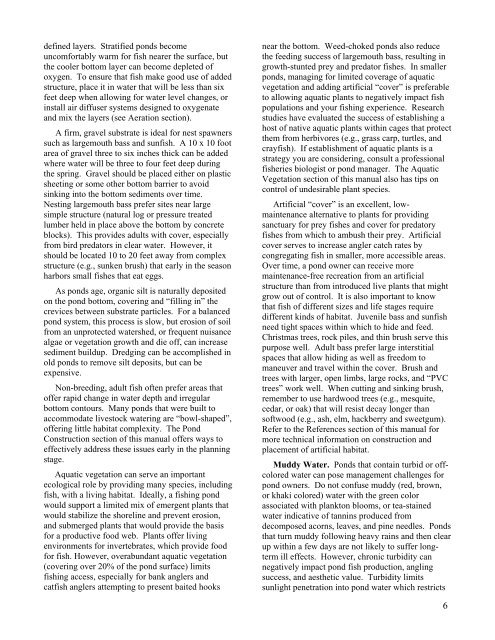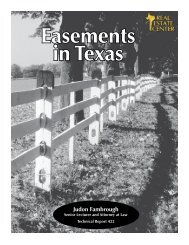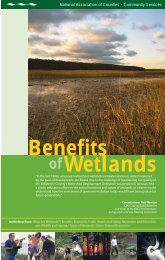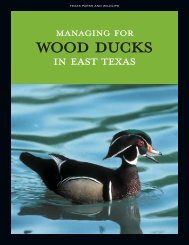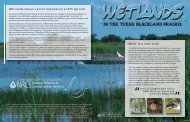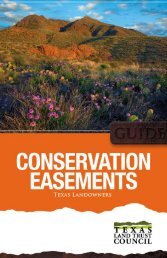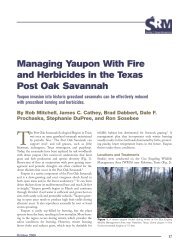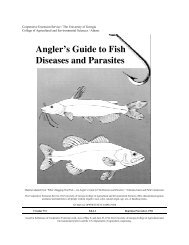Texas Farm Ponds: Stocking, Assessment, and Management ...
Texas Farm Ponds: Stocking, Assessment, and Management ...
Texas Farm Ponds: Stocking, Assessment, and Management ...
Create successful ePaper yourself
Turn your PDF publications into a flip-book with our unique Google optimized e-Paper software.
defined layers. Stratified ponds become<br />
uncomfortably warm for fish nearer the surface, but<br />
the cooler bottom layer can become depleted of<br />
oxygen. To ensure that fish make good use of added<br />
structure, place it in water that will be less than six<br />
feet deep when allowing for water level changes, or<br />
install air diffuser systems designed to oxygenate<br />
<strong>and</strong> mix the layers (see Aeration section).<br />
A firm, gravel substrate is ideal for nest spawners<br />
such as largemouth bass <strong>and</strong> sunfish. A 10 x 10 foot<br />
area of gravel three to six inches thick can be added<br />
where water will be three to four feet deep during<br />
the spring. Gravel should be placed either on plastic<br />
sheeting or some other bottom barrier to avoid<br />
sinking into the bottom sediments over time.<br />
Nesting largemouth bass prefer sites near large<br />
simple structure (natural log or pressure treated<br />
lumber held in place above the bottom by concrete<br />
blocks). This provides adults with cover, especially<br />
from bird predators in clear water. However, it<br />
should be located 10 to 20 feet away from complex<br />
structure (e.g., sunken brush) that early in the season<br />
harbors small fishes that eat eggs.<br />
As ponds age, organic silt is naturally deposited<br />
on the pond bottom, covering <strong>and</strong> “filling in” the<br />
crevices between substrate particles. For a balanced<br />
pond system, this process is slow, but erosion of soil<br />
from an unprotected watershed, or frequent nuisance<br />
algae or vegetation growth <strong>and</strong> die off, can increase<br />
sediment buildup. Dredging can be accomplished in<br />
old ponds to remove silt deposits, but can be<br />
expensive.<br />
Non-breeding, adult fish often prefer areas that<br />
offer rapid change in water depth <strong>and</strong> irregular<br />
bottom contours. Many ponds that were built to<br />
accommodate livestock watering are “bowl-shaped”,<br />
offering little habitat complexity. The Pond<br />
Construction section of this manual offers ways to<br />
effectively address these issues early in the planning<br />
stage.<br />
Aquatic vegetation can serve an important<br />
ecological role by providing many species, including<br />
fish, with a living habitat. Ideally, a fishing pond<br />
would support a limited mix of emergent plants that<br />
would stabilize the shoreline <strong>and</strong> prevent erosion,<br />
<strong>and</strong> submerged plants that would provide the basis<br />
for a productive food web. Plants offer living<br />
environments for invertebrates, which provide food<br />
for fish. However, overabundant aquatic vegetation<br />
(covering over 20% of the pond surface) limits<br />
fishing access, especially for bank anglers <strong>and</strong><br />
catfish anglers attempting to present baited hooks<br />
near the bottom. Weed-choked ponds also reduce<br />
the feeding success of largemouth bass, resulting in<br />
growth-stunted prey <strong>and</strong> predator fishes. In smaller<br />
ponds, managing for limited coverage of aquatic<br />
vegetation <strong>and</strong> adding artificial “cover” is preferable<br />
to allowing aquatic plants to negatively impact fish<br />
populations <strong>and</strong> your fishing experience. Research<br />
studies have evaluated the success of establishing a<br />
host of native aquatic plants within cages that protect<br />
them from herbivores (e.g., grass carp, turtles, <strong>and</strong><br />
crayfish). If establishment of aquatic plants is a<br />
strategy you are considering, consult a professional<br />
fisheries biologist or pond manager. The Aquatic<br />
Vegetation section of this manual also has tips on<br />
control of undesirable plant species.<br />
Artificial “cover” is an excellent, lowmaintenance<br />
alternative to plants for providing<br />
sanctuary for prey fishes <strong>and</strong> cover for predatory<br />
fishes from which to ambush their prey. Artificial<br />
cover serves to increase angler catch rates by<br />
congregating fish in smaller, more accessible areas.<br />
Over time, a pond owner can receive more<br />
maintenance-free recreation from an artificial<br />
structure than from introduced live plants that might<br />
grow out of control. It is also important to know<br />
that fish of different sizes <strong>and</strong> life stages require<br />
different kinds of habitat. Juvenile bass <strong>and</strong> sunfish<br />
need tight spaces within which to hide <strong>and</strong> feed.<br />
Christmas trees, rock piles, <strong>and</strong> thin brush serve this<br />
purpose well. Adult bass prefer large interstitial<br />
spaces that allow hiding as well as freedom to<br />
maneuver <strong>and</strong> travel within the cover. Brush <strong>and</strong><br />
trees with larger, open limbs, large rocks, <strong>and</strong> “PVC<br />
trees” work well. When cutting <strong>and</strong> sinking brush,<br />
remember to use hardwood trees (e.g., mesquite,<br />
cedar, or oak) that will resist decay longer than<br />
softwood (e.g., ash, elm, hackberry <strong>and</strong> sweetgum).<br />
Refer to the References section of this manual for<br />
more technical information on construction <strong>and</strong><br />
placement of artificial habitat.<br />
Muddy Water. <strong>Ponds</strong> that contain turbid or offcolored<br />
water can pose management challenges for<br />
pond owners. Do not confuse muddy (red, brown,<br />
or khaki colored) water with the green color<br />
associated with plankton blooms, or tea-stained<br />
water indicative of tannins produced from<br />
decomposed acorns, leaves, <strong>and</strong> pine needles. <strong>Ponds</strong><br />
that turn muddy following heavy rains <strong>and</strong> then clear<br />
up within a few days are not likely to suffer longterm<br />
ill effects. However, chronic turbidity can<br />
negatively impact pond fish production, angling<br />
success, <strong>and</strong> aesthetic value. Turbidity limits<br />
sunlight penetration into pond water which restricts<br />
6


